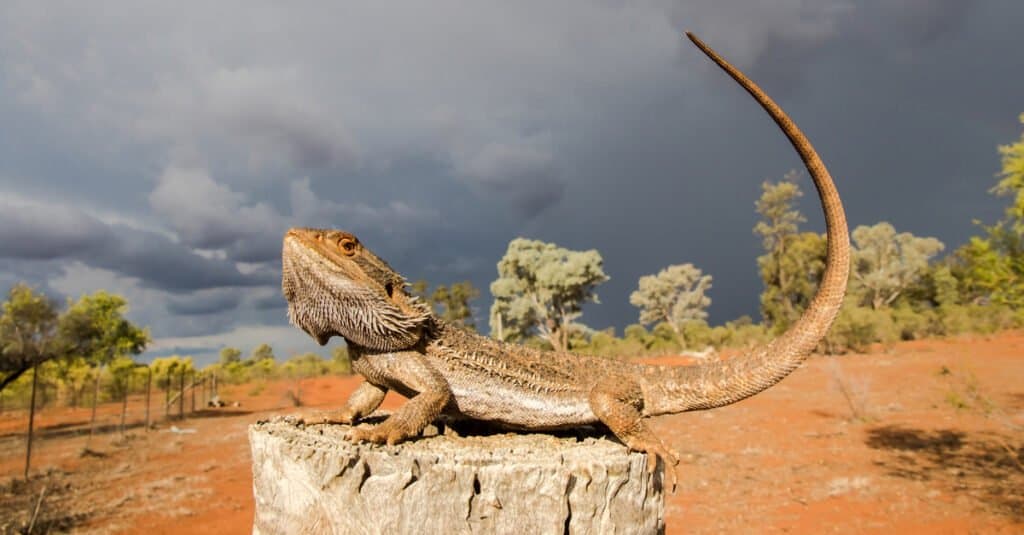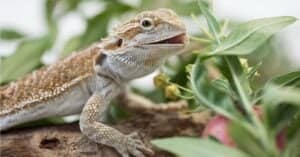Bearded dragons are fascinating little lizards, and they’ve taken the reptile-keeping world by storm over the past few decades. But where do bearded dragons actually live in the wild? Let’s take a closer look at where they come from below, as well as how they survive and reproduce in their natural habitats.
The Wild Bearded Dragon’s Natural Habitat

Bearded dragons live in very hot, dry habitats.
©Ken Griffiths/Shutterstock.com
To be clear, there are actually six unique species of bearded dragons that fall under the Pogona genus of agamid lizards taxonomically. These include the central, eastern, western, Rankin’s, Kimberley, and Nullarbor bearded dragons. All of these lizards are collectively known as bearded dragons. However, the central or inland variety, Pogona vitticeps, is the most widespread and common in the exotic pet-keeping world.
All six varieties of bearded dragons are native to Australia, with most of them preferring the hottest and driest parts of the continent towards its easternmost reaches. They are also quite adaptable and are sometimes found in subtropical woodland areas and savannas. Some members of the bearded dragon family of lizards have now spread to southern Asia, but their overall habitat preference remains the same.
In general, a bearded dragon’s habitat is very dry and hot, with plenty of sand and dirt substrate for burrowing. It isn’t uncommon for temperatures to rise well into the 90s and 100s Fahrenheit. While rain is also usually fairly scarce in these areas, these resilient lizards fare just fine. They can go several days without water and will even stand on their front two limbs, sloping their tails and bodies downward so the rain falls directly into their mouths!
Additionally, bearded dragons are also semi-arboreal lizards. This means they enjoy a fair bit of climbing on trees and rocks in the wild as well. They are speedy both on land and as climbers, making them adept at traversing their rough habitats that are downright inhospitable for many other animals. They are even skilled at swimming, too!
Overall, bearded dragons are right at home in their dry, hot, desert-like habitats. They should have a similar habitat setup in captivity, too.
What Do Wild Bearded Dragons Eat?

Wild bearded dragons feed on just about anything small enough to fit in their mouths. They prefer insects like
roaches
,
beetles
, and
cicadas
.
©iStock.com/Ken Griffiths
Wild bearded dragons are omnivorous, meaning they eat a wide range of animal and plant material to survive. While captive beardies generally get a more balanced diet, in the wild, they simply eat what they can to get by. Their diets can include all manner of insects, spiders, and worms when it comes to animal matter.
In addition to a wide range of small insects, arthropods, and worms, bearded dragons will also occasionally eat other small animals. This can even include other smaller lizards and rodents! These alternative food sources can help wild bearded dragons get the protein they need to thrive.
Bearded dragons, particularly of the wild variety, are skilled ambush hunters. They use their powerful jaws, sharp, serrated teeth, and large, muscular triangle-shaped heads to tear into small animals and insects across the Australian Outback with ease. As diurnal animals, they mostly hunt for their meals during the day. At night, they find burrows in which to rest and hide from their predators, such as birds and larger lizards like goannas.
When it comes to plant matter, wild beardies also aren’t terribly picky. They’ll munch on just about any leafy green material they find, as well as wild-growing berries and brush. They’ll also lick rain water off of the plants they find to stay hydrated in their harsh, unforgiving habitat.
How Long Do Wild Bearded Dragons Live?
While a captive, well-cared-for bearded dragon’s lifespan can range from 7 to more than 15 years in some cases, their wild counterparts generally don’t live nearly as long. This is due to many factors, with predation being the lizards’ biggest threat. As we touched on earlier, a wide range of animals feed on bearded dragons in the wild, including birds, snakes, and larger monitor lizards.
Generally, a wild beardie can be expected to live for anywhere from 3 to 8 years. They reach sexual maturity at around one to two years of age and reproduce in the spring and summertime, following a brumation period in the winter. Wild bearded dragons reach maturity and seek their mates quickly following brumation to ensure the further survival of their species.
How Do Wild Bearded Dragons Reproduce?
Once they come out of their brumatory burrows, mature male and female bearded dragons immediately begin seeking mates. The males interact with the females via gestures like head bobbing and arm waving. When both are ready to mate, the male climbs on top of the female and bites onto the back of her neck to stay in position while copulating.
Female bearded dragons can lay clutches of around 11 to 30 eggs at a time. However, they can occasionally lay fewer eggs than this. After a successful mating session, it usually takes around 2 to 5 weeks for the female to lay her clutch. In the wild, females lay their eggs in well-dug burrows to keep them warm and protected from predators.
After this, it takes around two months for the eggs to hatch into baby lizards. The mother doesn’t stick around to look after the baby lizards. As a result, the babies are on their own from birth. Fortunately, they’re equipped with sharp teeth and fast, powerful limbs from the start of their lives. This allows them to immediately seek out and munch on plenty of insects and other small animals to get the protein they need to quickly grow into mature lizards.
The photo featured at the top of this post is © Ken Griffiths/Shutterstock.com
Thank you for reading! Have some feedback for us? Contact the AZ Animals editorial team.






